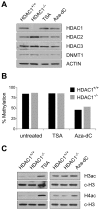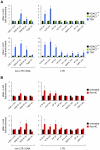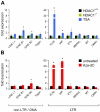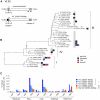Epigenetic regulation of a murine retrotransposon by a dual histone modification mark
- PMID: 20442873
- PMCID: PMC2861705
- DOI: 10.1371/journal.pgen.1000927
Epigenetic regulation of a murine retrotransposon by a dual histone modification mark
Erratum in
- PLoS Genet. 2011;7(1). doi: 10.1371/annotation/4ec9cbbd-7620-4449-8961-28213e9dadf4
Abstract
Large fractions of eukaryotic genomes contain repetitive sequences of which the vast majority is derived from transposable elements (TEs). In order to inactivate those potentially harmful elements, host organisms silence TEs via methylation of transposon DNA and packaging into chromatin associated with repressive histone marks. The contribution of individual histone modifications in this process is not completely resolved. Therefore, we aimed to define the role of reversible histone acetylation, a modification commonly associated with transcriptional activity, in transcriptional regulation of murine TEs. We surveyed histone acetylation patterns and expression levels of ten different murine TEs in mouse fibroblasts with altered histone acetylation levels, which was achieved via chemical HDAC inhibition with trichostatin A (TSA), or genetic inactivation of the major deacetylase HDAC1. We found that one LTR retrotransposon family encompassing virus-like 30S elements (VL30) showed significant histone H3 hyperacetylation and strong transcriptional activation in response to TSA treatment. Analysis of VL30 transcripts revealed that increased VL30 transcription is due to enhanced expression of a limited number of genomic elements, with one locus being particularly responsive to HDAC inhibition. Importantly, transcriptional induction of VL30 was entirely dependent on the activation of MAP kinase pathways, resulting in serine 10 phosphorylation at histone H3. Stimulation of MAP kinase cascades together with HDAC inhibition led to simultaneous phosphorylation and acetylation (phosphoacetylation) of histone H3 at the VL30 regulatory region. The presence of the phosphoacetylation mark at VL30 LTRs was linked with full transcriptional activation of the mobile element. Our data indicate that the activity of different TEs is controlled by distinct chromatin modifications. We show that activation of a specific mobile element is linked to a dual epigenetic mark and propose a model whereby phosphoacetylation of histone H3 is crucial for full transcriptional activation of VL30 elements.
Conflict of interest statement
The authors have declared that no competing interests exist.
Figures







Similar articles
-
Activation of the mouse histone deacetylase 1 gene by cooperative histone phosphorylation and acetylation.Mol Cell Biol. 2002 Nov;22(22):7820-30. doi: 10.1128/MCB.22.22.7820-7830.2002. Mol Cell Biol. 2002. PMID: 12391151 Free PMC article.
-
Genome-wide profiling of histone H3 lysine 9 acetylation and dimethylation in Arabidopsis reveals correlation between multiple histone marks and gene expression.Plant Mol Biol. 2010 Apr;72(6):585-95. doi: 10.1007/s11103-009-9594-7. Plant Mol Biol. 2010. PMID: 20054610
-
Coordinated changes in DNA methylation and histone modifications regulate silencing/derepression of luteinizing hormone receptor gene transcription.Mol Cell Biol. 2005 Sep;25(18):7929-39. doi: 10.1128/MCB.25.18.7929-7939.2005. Mol Cell Biol. 2005. PMID: 16135786 Free PMC article.
-
Epigenetic control of ovarian function: the emerging role of histone modifications.Mol Cell Endocrinol. 2005 Nov 24;243(1-2):12-8. doi: 10.1016/j.mce.2005.09.005. Epub 2005 Oct 10. Mol Cell Endocrinol. 2005. PMID: 16219412 Review.
-
Epigenetic landscape of amphetamine and methamphetamine addiction in rodents.Epigenetics. 2015;10(7):574-80. doi: 10.1080/15592294.2015.1055441. Epigenetics. 2015. PMID: 26023847 Free PMC article. Review.
Cited by
-
ROS Signaling-Mediated Novel Biological Targets: Brf1 and RNA Pol III Genes.Oxid Med Cell Longev. 2021 Oct 4;2021:5888432. doi: 10.1155/2021/5888432. eCollection 2021. Oxid Med Cell Longev. 2021. Retraction in: Oxid Med Cell Longev. 2024 Jan 9;2024:9890237. doi: 10.1155/2024/9890237. PMID: 34646425 Free PMC article. Retracted. Review.
-
Epigenetic control of mobile DNA as an interface between experience and genome change.Front Genet. 2014 Apr 25;5:87. doi: 10.3389/fgene.2014.00087. eCollection 2014. Front Genet. 2014. PMID: 24795749 Free PMC article. Review.
-
Tinzaparin inhibits VL30 retrotransposition induced by oxidative stress and/or VEGF in HC11 mouse progenitor mammary cells: Association between inhibition of cancer stem cell proliferation and mammosphere disaggregation.Oncol Rep. 2021 Nov;46(5):241. doi: 10.3892/or.2021.8192. Epub 2021 Sep 24. Oncol Rep. 2021. PMID: 34558648 Free PMC article.
-
Trim24-repressed VL30 retrotransposons regulate gene expression by producing noncoding RNA.Nat Struct Mol Biol. 2013 Mar;20(3):339-46. doi: 10.1038/nsmb.2496. Epub 2013 Feb 3. Nat Struct Mol Biol. 2013. PMID: 23377542
-
Histone H3 phosphorylation - a versatile chromatin modification for different occasions.Biochimie. 2012 Nov;94(11):2193-201. doi: 10.1016/j.biochi.2012.04.018. Epub 2012 Apr 28. Biochimie. 2012. PMID: 22564826 Free PMC article. Review.
References
-
- Strahl BD, Allis CD. The language of covalent histone modifications. Nature. 2000;403:41–45. - PubMed
-
- Marks P, Rifkind RA, Richon VM, Breslow R, Miller T, et al. Histone deacetylases and cancer: causes and therapies. Nat Rev Cancer. 2001;1:194–202. - PubMed
-
- Shankar S, Srivastava RK. Histone deacetylase inhibitors: mechanisms and clinical significance in cancer: HDAC inhibitor-induced apoptosis. Adv Exp Med Biol. 2008;615:261–298. - PubMed
Publication types
MeSH terms
Substances
Grants and funding
LinkOut - more resources
Full Text Sources
Research Materials
Miscellaneous

